| < Previous page | Next page > |
HillsideGeneric Erosion Potential (GEP) - Hillside
Parameter Description: The susceptibility of hillslopes to shallow failure and to gullying based on a topographic index combining slope steepness with slope convergence. Slope steepness is a fundamental control on erosion potential. Convergence causes surface and subsurface flow to become concentrated and therefore contributes to erosion potential. See also Shallow Landslide intensity, which is a calibrated version of GEP.
There are three model components: (1) erosion potential with delivery to streams not considered, (2) erosion potential areas that deliver sediment and organic debris to streams, and (3) modification of erosion potential based on a user supplied multiplier to reflect changes to inherent erosion potential due to geology, soils. vegetation, climate, and land use. Note that in the context of sediment delivery, a user may define the channel gradient threshold that governs delivery, e.g., a delivery threshold of less than or equal to 20% will reveal more areas that can deliver compared to a delivery threshold of 10% (see Delivery Tool).
Important Notice: This erosion model is not calibrated to any particular area. Although the model employs universal topographic indicators of shallow landslide potential (and also gully potential), increased accuracy and resolution can be obtained when the GEP index is calibrated using local data (georeferenced locations of landslides or gullies). TerrainWorks has developed a landslide calibration tool, contact us for additional details . Also see Warning about using Slope Stability Models.
Data Type: Grid
Field Name: GEP_GRID; Common Name: Erosion (Hillside Grid)
Field Name: GEPDEL_GRID; Common Name: Generic Erosion Potential-Delivered (note, delivery to channels of a specific gradient threshold is set by the user using the Delivery Tool)
Field Name: GEPMOD_GRID; Common Name: Generic Erosion Potential-Modified
Units: Numerical values, range from 0 to >1
NetMap Module/Tool: Erosion Module/Generic Erosion Potential (GEP)
Generic Erosion Potential (GEP), based on slope steepness and convergence, represents the potential for at least three different types of erosion and hazards (see Figure below).
 Model Description (1/3): Generic Erosion Potential (delivery not considered)
NetMap’s generic erosion potential (GEP) provides a relative measure of potential erosion and it focuses on slope steepness and convergence, recognized topographic indicators of shallow landsliding, gully erosion, and sheetwash (Montgomery and Dietrich 1995, Miller and Burnett 2007, Parker et al. 2010). It is based on topographic attributes of slope gradient, local contributing area, and topographic convergence derived from the DEM:
GEP = S*aL/b
where S is slope gradient (m/m), aL is a measure of local contributing area to a DEM pixel equal to the number of adjacent pixels that drain into it (varies between 0 and 8), and b is a measure of topographic convergence equal to the projection of flow direction out of a pixel onto the pixel edges. Values of b are 1 on planar slopes, less than 1 on convergent topography, and greater than 1 on divergent topography. Larger values of GEP correspond to steeper, more convergent topography. Higher values of GEP correspond to higher landslide densities and, in areas prone to surface erosion, to higher gully-initiation-point densities (Miller and Burnett 2007). NetMap’s GEP index provides a relative measure of erosion potential (e.g., high – low) that encompasses processes of shallow landsliding, gullying, and surface erosion and which can be used in both humid and semi arid landscapes. GEP is referred to as “Erosion” in the Field legend editor. Refer to Figures 1 and 2 on tool use.
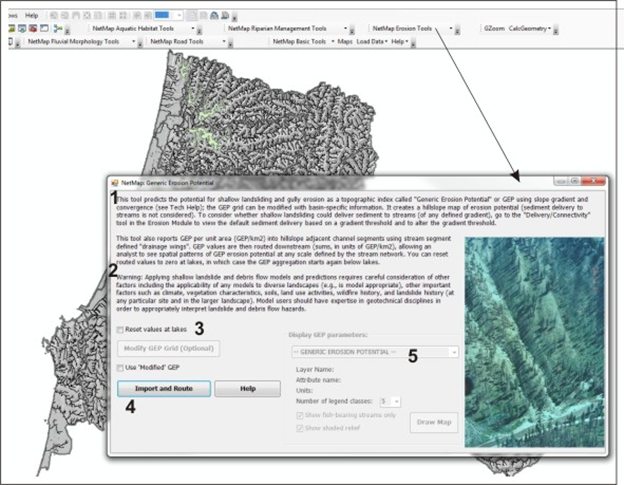 Figure 1. NetMap's Generic Erosion Potential tool (GEP) uses an index of hillslope gradient and convergence (1) and is appropriate in any landscape prone to shallow landslides and gully erosion. Use of the tool is best done by analysts with some background in slope stability (2). When first running this tool in a watershed, a user decides to "reset values at lakes" (3) in the channel based attribute of the GEP index (e.g., GEP values summarized to reaches at the scale of drainage wings and then routed downstream) or to not reset at lakes. For example, if GEP is considered an index of erosion and sediment yield potential (rather than just an index of slope stability hazards), then sediment routed downstream will become intercepted by lakes, and thus a user might want to use the "reset values at lakes" option. Then a user imports the data (4) and the tool automatically routes the data to individual stream segments (a fish eye view of erosion potential) and then downstream.
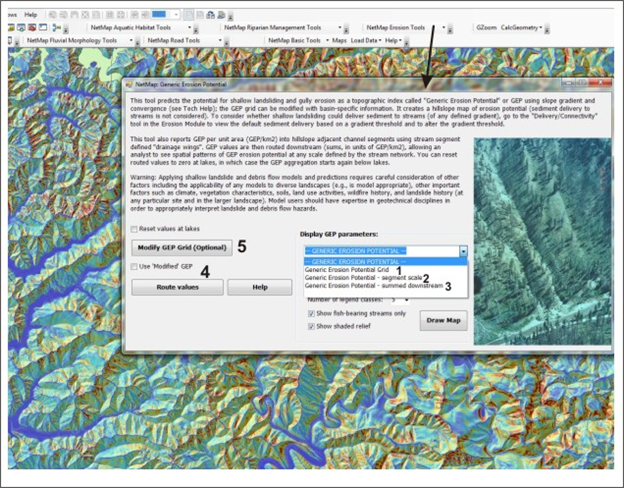 Figure 2. Once the Generic Erosion Potential data have been imported, three types of attributes are available for display: (1) the hillside prediction (Grid), (2) the in-stream value (accumulated from both sides of the channel, via Drainage Wings, and (3) the downstream routed or aggregated values. Reach scale GEP values can be routed (after the first time when it was done automatically) and values can be reset at lakes if required. A modified GEP prediction can be made if a user supplies a set of polygons that have multipliers of GEP values (increases or decreases); GEP based sediment yield predictions (t/km2/yr) can also be predicted using the modification procedure (Figure 3).
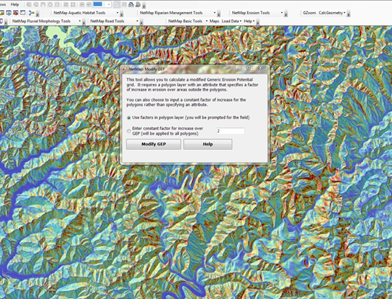 Figure 3. A analyst can import a polygon shape file that includes an attribute for a factor of increase or decrease which can be applied to the GEP index, thereby increasing or decreasing the erosion risk based on factors related to lithology, soil, vegetation and other land use. The modified GEP index can then be converted to sediment yield, similarly to the standard GEP conversion to sediment yield.
Model Description (2/3): Erosion Delivery to Streams;
Field Name: GEP_DEL_GRID; Common Name: Generic Erosion Potential-Delivered
To calculate the potential for sediment delivery to streams (from predicted shallow landslide areas), the model traces the down slope flow path from every pixel until it intersects a stream. The calculated probability for sediment to be transferred to each downslope cell decreases monotonically as a function of gradient and topographic convergence. [Sediment delivery applies to mass wasting sediment delivery, say by debris flow or landslide. It does not apply to surface erosion processes, which is handled by the WEPP surface erosion model.] The probability that sediment will reach a stream is assigned to the source cell. This is repeated for all hillslope pixels. The predicted delivery of landslides to stream channels is based on a channel gradient threshold. For example, the Delivery Tool is used to estimate delivery potential to channels with a gradient equal to or less than 5%, 8% or 30% etc. (Figure 4).
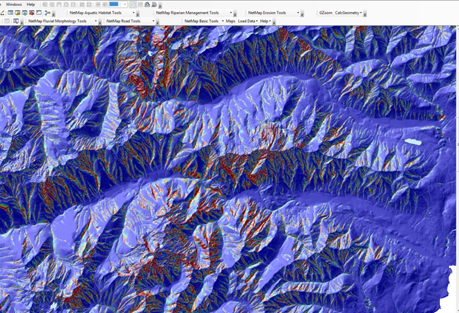 Figure 4. NetMap contains a tool for predicting the sediment (and wood) delivery to stream channels. Although the datasets are created using a default channel gradient threshold, a user can recalculate sediment delivery based on a new channel gradient threshold (i.e., 5%, 10%, 20% etc.).
Background
When compared to an extensive landslide inventory in the Oregon Coast Range (Robison et al. 1999, Bush et al. 1997), the index function performed better than hillslope gradient alone or other shallow landslide models (Miller and Burnett 2007a). Generic erosion potential (GEP) is applicable to any landscape since steep, convergent areas are preferential locations for many forms of erosion (e.g., Figure 5). However, erosion potential should be considered only in the context of additional information on climate and vegetation, parameters that are discussed later. For example, steep and convergent areas in humid landscapes are more susceptible to shallow landslides and debris flows during heavy rain and rain-on-snow compared to similar landforms in semi-arid landscapes where convergent landforms may pose less of an erosion hazard due to gradual spring snowmelt runoff, with the exception of post-fire gullying. In addition, the erosion potential associated with steep and convergent topography does not address other important erosion processes such as deep-seated rotational failures and earthflows. Thus GEP may not be applicable in some landscapes dominated by deeper forms of failures, although GEP should still apply to surface types of erosion such as shallow failures, gullying, and surface erosion on deep-seated features (Figure 6).
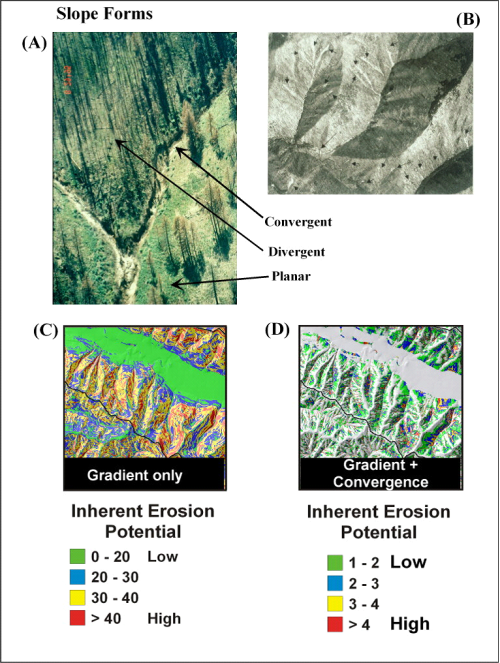 Figure 5. Steep, convergent areas in many landscapes are prone to various forms of erosion including (A) gullying in semi-arid areas, particularly following fires and (B) shallow failures in humid landscapes. Hillslopes can be categorized into (A) convergent, divergent, and planar forms. Slope gradient alone (C) can be used as an approximate indicator of erosion potential since all forms of erosion are strongly governed by slope. A more accurate predictor of erosion potential is slope combined with a measure of topographic convergence to create an intrinsic index of erosion potential (D). NetMap’s GEP index that uses both slope and convergence provides a useful screening of erosion potential across large areas (Figure 2).
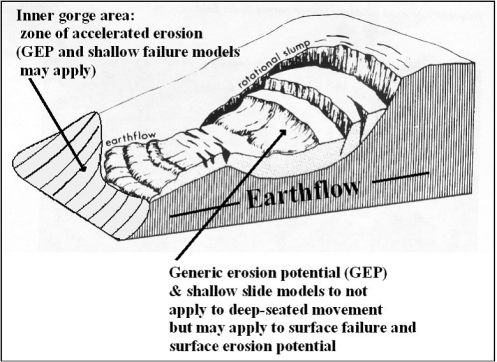 Figure 6. Generic erosion potential and shallow landslide models apply to erosion potential (mass wasting and post-fire surface erosion) that is driven by hillslope gradient and convergence. GEP-type models may also apply to areas not captured by topographic expression on 10-m DEMs such as inner gorges near streams. GEP-type models do not apply to deeper movement in earthflows and rotational slumps but may apply to surface erosion processes on the slope of deep-seated features.
 Figure 7. (Top) The NetMap parameter of Generic Erosion Potential (GEP) identifies steep and convergent areas providing a relativistic ranking of erosion potential targeting shallow landslides, debris flows and surface erosion and gullying. (Bottom) GEP is adjusted according to its potential for sediment delivery to streams; this applies only to mass wasting processes and it does not apply to surface erosion sediment delivery.
Delivery or Connectivity Potential
To calculate the potential for sediment delivery (for GEP type land, that is, where hillslope steepness and convergence promote erosion, including shallow failure), the model traces the down slope flow path until it intersects a stream. The calculated probability for sediment to be transferred to each downslope cell decreases monotonically as a function of gradient and topographic confinement (based on field data from the Oregon Coast Range, see Miller and Burnett 2007a). [note: sediment delivery applies to mass wasting sediment delivery, say by debris flow or landslide. It also does not apply to surface erosion processes.] The probability that sediment will reach a stream is assigned to the source cell. This is repeated for all hillslope pixels. The resulting raster file provides a map of potential for sediment delivery (to a stream) for every pixel cell in a basin. The probability of sediment delivery is then multiplied to the GEP value, thus providing a prediction of sediment delivery from GEP ranked hillslopes (Figure 6).
Model Description (3/3): Modifying GEP Values Due to Additional Factors
Field Name: GEP_MOD_GRID; Common Name: Mod-Generic Erosion Potential Grid
Field Name: GEPMod; Common Name: Mod-Generic Erosion Potential-segment scale
Field Name: GEPMod_CUM; Common Name: Mod-Generic Erosion Potential-summed downstream
GEP or GEP-Delivered values can be modified (increased or decreased) based on basin specific information on hillslope erosion potential. For example, in areas of uniform GEP values (hillslopesof similar topography), erosion potential related to shallow failures, surface erosion or gullying may vary due to differences in lithology, soil texture, soil depth, and land use. Thus GEP or GEP Delivery values can be modified by the user. This involves increasing (or decreasing) GEP values in specific areas by some factor. The user imports a polygon layer (see with a field called ‘Factor’ (Figure 7). In the polygons specified, GEP values are modified by the factor, producing a map of GEP values that reflects variation in erosion potential (Figure 8).
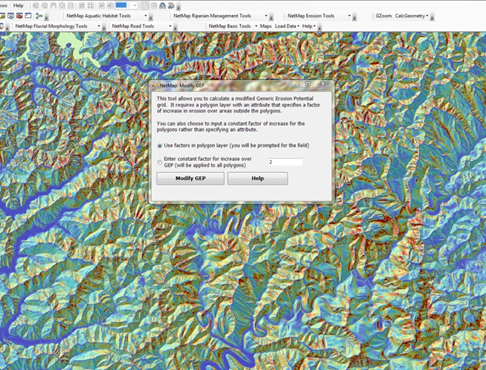 Figure 7. Analysts can modify the GEP or GEP (delivered) parameters (grids) using specified factors of increase or decrease, either in shape files or using a fixed value; a polygon shape file is required. For example, certain types of land use (timber harvest) may increase GEP values and certain types of lithologies could decrease GEP values. The tool can be applied to the GEP grid or the GEP delivered grid (3, 4). See Figure 10. The modified GEP index can then be converted to sediment yield, similarly to the standard GEP conversion to sediment yield.
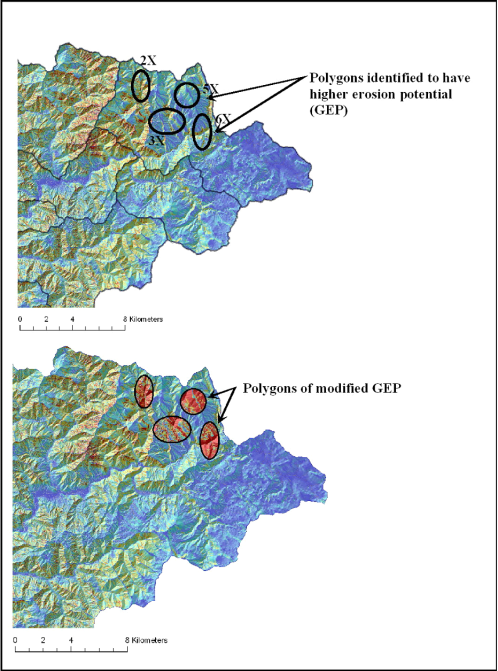 Figure 8. Based on site-specific information on erosion potential, Generic Erosion Potential values (GEP) can be modified by importing a polygon layer with assigned factors of increase or decrease in the attribute table. (TOP) Basic GEP values with polygons identified along with their factors of increase are shown. (Bottom) By using the modify GEP tool in NetMap, regular GEP values are modified (increased) in each of the polygons according to the factors of increase shown above.
How does an analyst relate GEP values to actual landslide potential? Landslides can be mapped using aerial photography and or ground surveys (ref). Georeferenced incidences of landslides can be overlain on maps of predicted erosion, such as GEP (Figure 9). Using this approach, it is feasible to assign a GEP value threshold to a certain spatial density or occurrence of landslides, and to estimate what proportion of the landslide risk is related to what proportion of the land area (Figure 10).
 Figure 9. Locations of landslides (shallow failures) are overlain on a map of landslide potential (GEP). This will allow a relationship to be built that links landslide occurrence (or their spatial frequency of occurrence) to predicted erosion potential. This can lead to an estimate of what proportion of land area is related to what proportion of landslide risk (Figure 8).
 Figure 10. (A) The cumulative distribution of slope gradients (excluding wide valley floors) reveals that hillslopes with gradients in excess of 72% occur on only 16% of the land surface area. This value was used in (B), the cumulative distribution of GEP values (computer mapping), to determine the threshold value of GEP that would correspond to steep and convergent high hazard zones.
More Background:
Hillslope gradient fundamentally controls erosion type and magnitude (Dunne and Leopold 1978) (Figure 11). For instance, in humid environments the highest density of shallow failures due to heavy precipitation occurs on slopes in excess of approximately 35° (> 72%) (Dragovich et al. 1993). Hillslope gradient is also a factor controlling the location of gully erosion that often occurs following fire in some landscapes; erosion is generally more intense on steeper slopes that are convergent (Istanbullouglu et al. 2003). Surface erosion occurs on more gentle terrain, although its magnitude is directly proportional to slope gradient (Elliot et al. 2000).
The morphological form of hillslopes that is related to erosion is often classified into several types, including convergent, divergent, and planar (Figure 4, A). Convergent areas, also referred to as swales, bedrock hollows, and zero-order basins, focus the transport of sediment and water. Over time (centuries), soil creep causes soils to thicken in convergent areas making them more susceptible to landsliding (Sidle 1987). During storms, convergent areas also focus shallow subsurface flow thereby increasing saturation and making them more susceptible to failures. Convergent areas also concentrate overland flow making them focal areas for gully development, particularly after fire. Steep convergent areas in humid landscapes also are a major initiation point for debris flows in low-order streams (Dietrich and Dunne, 1978) (Figure 4, B).
To estimate the intrinsic erosion potential of a watershed, NetMap generates maps of hillslope gradient, and maps of gradient combined with curvature, the latter an erosion index (Figure 4,C, D). The generic erosion index employs a combination of slope gradient and local topographic convergence given by (AL*S)/b, where b is a measure of local topographic convergence (the length of an elevation contour crossed by flow out of the pixel, values less than one pixel length indicate convergent topography), AL is a measure of local contributing area (within one pixel length), and S is slope gradient (Miller and Burnett in review, Miller 2005).
Generic erosion potential (GEP) provides a relatively conservative prediction of erosion prone lands across a variety of landscapes since it focuses on slope gradient and convergent (Figure 3, Top). GEP is not a calibrated function; calibration could be used to tighten up the predictions of potentially unstable lands. However, detailed erosion surveys, including landsliding, would be necessary. GEP should be used in conjunction with information on erosion processes and climate in areas where there is little or no information on erosion mechanisms or rates. For example, high GEP in temperate humid landscapes (such as the Oregon Coast Range) may have very different implications compared to semi-arid areas in eastern Oregon that erode infrequently by sheetwash and gully erosion following fires. Also in areas dominated by mass wasting (and in areas during non-fire episodes) it is recommended that GEP Delivery parameter is used (Figure 3, Bottom).
Slope gradient can be uses as a measure of erosion potential, although NetMap’s GEP, shallow failure, debris flow and surface erosion predictions provide additional information. Using slope gradient or GEP alone, for example, cumulative distributions can be created across entire watersheds (using NetMap’s CDF tool) to rank the erosion potential across different basins (Figure 12). The CDF identifies the proportion of watershed area susceptible to certain types of erosion (an interpretation conditioned by fire and precipitation regimes, etc.). For example, the proportion of the slope gradient CDF greater than 35o ranges from 0% to 15% across the example basins shown in Figure 10. Heterogeneity of hillslope gradients reflected in a CDF (the spread of the distribution) also can reflect the diversity of erosion processes and hence the diversity of erosion rates within a basin. The CDF is used within a queryable database from which watersheds can be ranked with respect to inherent erosion potential.
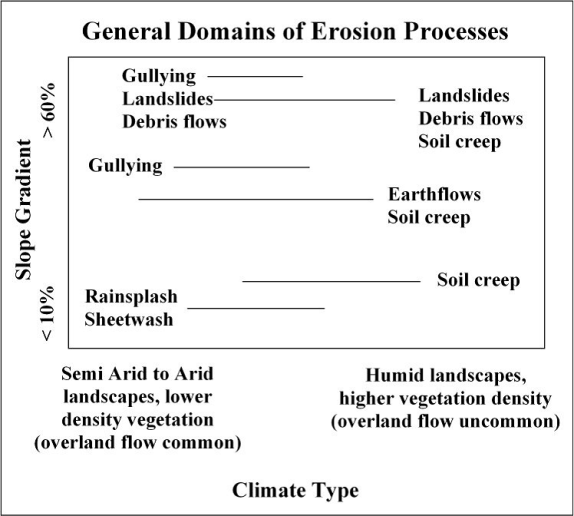 Figure 11. Hillslope gradients strongly influence the type of erosion that characterizes semi-arid to humid landscapes (adapted from Figure 15-1 of Dunne and Leopold [1978]).
 Figure 12. Creating CDFs of erosion indices such as gradient or gradient in combination with convergence allows for sorting and ranking erosion potential across a populations of watersheds for cross basin comparisons. NetMap includes a tool for calculating cumulative distributions (CDF) on the fly, as well as using that information to sort and rank some aggregated value of erosion potential (such as means or medians, etc.) across a population of subbasins. NetMap's Sort and Rank tool can also be used to classify a population of subbasins (such as 12 Digit, HUC 6th field) according to erosion potential (or sediment yield potential).
Computer based mapping of erosion potential can be compared to more qualitative approaches involving use of aerial photography, field inventories of failures and topographic maps. More qualitative approaches are commonly used in certain applications including assessing risk of landsliding associated with land use activities such as forestry and road building. See Figures 13 through 20 for examples comparing hand drawn maps with computer generated predictions of erosion potential (using GEP). Examples are from a watershed analysis in southwest Washington.
 Figure 13. Photo shows numerous landslides following a major winter storm in southwest Washington. Also shown are timber harvest areas and zones of restricted harvest (forested) located along landslide-prone stream valleys associated with high hazard landforms. Courtesy Washington Department of Natural Resources.
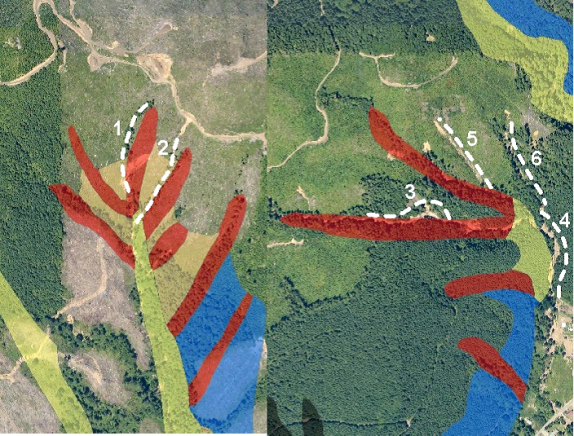 Figure 14. Hand drawn mass wasting map units are overlaid on digital imagery. This figure reveals the accuracies and inaccuracies of the hand-drawn map units with respect to the targeted landforms (steep (>72%) and convergent landforms in red and steep inner gorges in yellow). In many areas the hand-drawn slope stability maps (on paper 1:24,000 topographic maps) match well with the topography. However, in other areas the map units are not well aligned with the actual topography (the white dashed lines 1, 2, 3 and 4 indicate the miss-mapped locations of the target landforms). Moreover, in some areas the hand-drawn map units miss the landform completely (white dashed line 5 and 6). This limitation was acknowledged during the original (1996) assessment leading to a field implementation recommendation to use the map unit physical descriptions as the deciding factor in laying out harvest units rather than map itself.
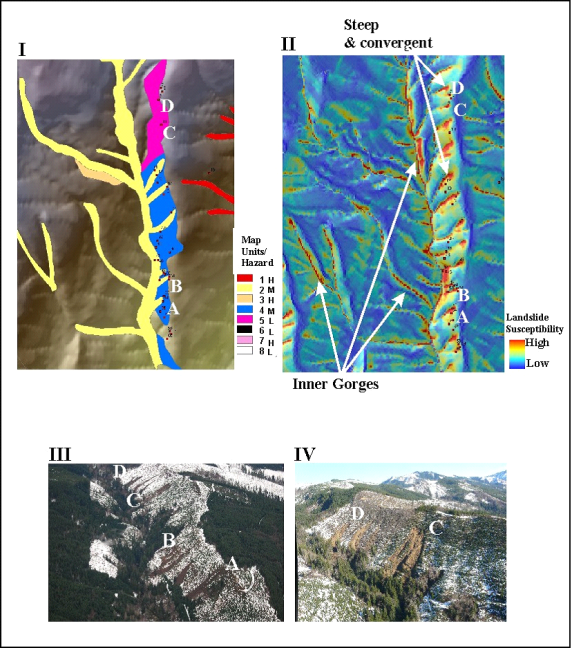 Figure 15. (I) Hand-drawn mass wasting map units and mapped occurrences of failures.
(II) Using NetMap, GEP erosion potential of the same area. (III, IV) Aerial photos of 2009 landslide sites. Slides A – D are shown on both map products as they appear in the field.
 Figure 16. (I) Hand-drawn slope stability map. (II) NetMap’s GEP model. (III, IV) Aerial photos of landslide sites. Slides A – C are shown on both map products and as they appear in the field. In this area, there is generally good agreement between the old and new technologies (I and II), although the computer-based tools (II using 10-m DEMs) provide greater detail.
 Figure 17. (I) Hand-drawn slope stability map. This map classified the sites of the large slides (A, B) as ‘low’ hazard because of low landslide rates (e.g., historically [1939-2006] no landslide occurrence) and the predicted low likelihood of direct delivery of sediment to fish-bearing streams. (II) NetMap’s GEP tool. This figure indicates some instability potential, although not nearly as great compared to steep and convergent areas (e.g., Figures 14 and 15). (III, IV) Aerial photos of landslide sites A and B.
Large landslides occurred in the central portion of the photo area that inundated the valley floor with mud and debris. The large landslides (A, B in III, IV) appear to have occurred in association with skid trails and logging roads (Figure 17). Thus, even though neither the hand-drawn maps or the computer model can detect this type of failure, the association with roads strongly suggest that mitigation measures can be applied to reduce the risk, such as ensuring that roads to not reroute and concentrate drainage. And see NetMap’s road analysis tools including Figure 20.
 Figure 18. The largest landslides appear to be in association with skid roads and perhaps more regularly used logging roads. The small black x and green square correspond to landslide inventory points.
 Figure 19. Computer mapping of potential instability overlaid upon hand-drawn mass wasting map units. This figure reveals how computer mapping can provide additional detail and extension of unstable features, particularly at the heads of hand-drawn map areas.
 Figure 20. Computer mapping of GEP (at pixel scale). This map allows a detailed analysis of runout potential of landslides and the potential of failures to deliver sediment to streams.
 Figure 18. Examples of computer-based tools showing debris flow susceptibility in the left panel (based on Miller and Burnett 2007b) and road-related landslide potential on the right panel using NetMap. Computer based tools utilizing digital data provide increased spatial detail about landslide potential, their downstream impacts, and the potential impacts of logging activities on landslide and surface erosion potential. The examples show debris fans at the base of small, steep tributaries can be hotspots for debris flow impacts to roads and structures. Sites A, B, and C reveal areas of varying susceptibility by debris flows. Sites D and E indicate areas were road drainage diversion or road fills may trigger landslides. Such tools could be used to create prioritization strategies for road maintenance and abandonment.
|